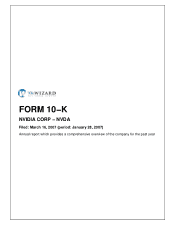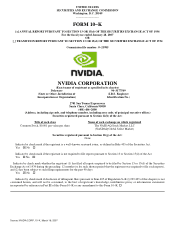NVIDIA 2007 Annual Report Download - page 10
Download and view the complete annual report
Please find page 10 of the 2007 NVIDIA annual report below. You can navigate through the pages in the report by either clicking on the pages listed below, or by using the keyword search tool below to find specific information within the annual report.
GeForce. The GeForce family represents our desktop GPUs and includes the GeForce 8, GeForce7, GeForce 6, and GeForce FX
families. During the first quarter of fiscal 2007, we shipped eight new GeForce 7 series GPUs for desktop and notebook PCs,
expanding our offering of products in the GeForce 7 GPU family. Also during the first quarter of fiscal 2007, we shipped our first
Quad SLI system for desktop PCs, enabling the use of four GPUs per system. During the second quarter of fiscal 2007, we shipped the
GeForce 7950 GX2, which provides the resolution of cinematic film and brought the 16:9 panoramic experience of cinema to gaming.
We also announced PureVideo HD technology, a combination of hardware acceleration from an NVIDIA GPU, high definition movie
player integration and HDCP feature support, to enable manufacturers and consumers to build PCs that can play HD DVD or Blu−ray
movies. In the fourth quarter of fiscal 2007, we introduced our flagship GPU series, the GeForce 8800. The GeForce 8800 is the
industry's first unified shader GPU to support the new Microsoft DirectX 10 API. The GeForce 8800 unified shader architecture can
adapt its computation resources to changing vertex and pixel shading workload from scene to scene, which enables programmers to
create more complex effects and imagery while simplifying the actual programming code. Our GeForce 7 GPU family, which is based
on the prior Microsoft DirectX 9.0 API, continues to deliver high price−per−performance from the mainstream to enthusiast segments
both in desktop and notebook PCs. We maintained our leading share in the desktop standalone GPU segment throughout fiscal 2007.
GeForce Go and NVIDIA Quadro Go. The GeForce Go and NVIDIA Quadro Go families represent our notebook GPUs and
include the GeForce 7 Go, GeForce 6 Go, and NVIDIA QuadroFX Go GPUs. These GPUs are designed to deliver desktop graphics
performance and features for multiple notebook configurations from desktop replacements, multimedia notebooks and thin−and−lights
to notebook workstations. The GeForce Go products are designed to serve the needs of both professional and consumer users. The
NVIDIA Quadro Go products are designed to serve the needs of workstation professionals in the area of product design and digital
content creation. In fiscal 2007, we introduced a complete family of notebook GPUs, the GeForce Go 7900, 7800, 7600 and 7400
families, all based on our second generation Shader Model 3.0 architecture and designed to deliver 3D, HD home theatre−quality
video and power management to the notebook segment. In March 2006, we shipped the GeForce Go 7900 and GeForce 7800 GTX
notebook products that feature SLI technology for notebook PCs. In early fiscal 2007, we launched our first notebook GPU, the
NVIDIA Quadro NVS, targeted specifically for business use. NVIDIA Quadro NVS graphics solutions provide business customers
with notebooks that are designed to be easy to deploy and maintain while minimizing total cost of ownership. We also launched the
NVIDIA Quadro FX 3500M, a mobile workstation graphic solution for computer aided design, or CAD, Digital Content Creation, and
Scientific Visualization. For the first time in our history, we captured the number one position in the notebook standalone GPU
segment during the second half of fiscal 2007, according to the Mercury Research Second Quarter 2006 PC Graphics Report.
NVIDIA Quadro. The NVIDIA Quadro branded products are professional workstation solutions that are available for high−end,
mid−range, entry−level and multi−display product lines. The NVIDIA Quadro family, which consists of the NVIDIA Quadro Plex
VCS, NVIDIA Quadro FX, NVIDIA Quadro4 and the NVIDIA Quadro NVS professional workstation processors, is designed to meet
the needs of a number of workstation applications such as industrial product design, digital content creation, non−linear video editing,
scientific and medical visualization, general purpose business and financial trading. NVIDIA Quadro products are fully certified by
several software developers for professional workstation applications and are designed to deliver the graphics performance and
precision required by professional applications. In August 2006, we introduced the NVIDIA Quadro Plex 1000, the world's first
dedicated Visual Computing System, or VCS. The NVIDIA Quadro Plex 1000 offers scalability in a desktop or dense three unit
rackmount configuration for professional applications such as those powering multiple streams of 4K high−definition video, 3D
styling and design, scientific and medical visualization, oil and gas exploration, or visual simulation and training.
MCPs. Our MCP product family, known as NVIDIA nForce, supports desktop PCs, notebook PCs, professional workstations and
servers.
NVIDIA nForce. The NVIDIA nForce family represents our MCPs for AMD and Intel−based desktop PCs, notebook PCs,
professional workstations and servers and includes the NVIDIA nForce4, NVIDIA nForce Professional, NVIDIA nForce 500 series
for AMD and Intel, NVIDIA nForce 600 series for AMD and Intel, and GeForce 6100 Series GPUs and nForce 400 Series MCP
motherboard solutions. We define an MCP as a single−chip or chipset that provides system functions, such as high speed storage and
network communications, and performs these operations independently from the host CPU. In fiscal 2006, we introduced the GeForce
6100 Series GPU and NVIDIA nForce 400 Series MCP. We offer the industry's first integrated core logic to feature DirectX 9.0 and
Shader Model 3.0 technology. In January 2006, we launched two new MCPs for the Intel platform, the NVIDIA nForce4 SLI XE and
NVIDIA nForce4 Ultra, both of which provide the system−builder and do−it−yourself communities with lower cost discrete
motherboard solutions for Intel PC platforms. In fiscal 2007, we began production shipments of our single−chip motherboard GPUs
for AMD−based PCs. In March 2006, we shipped our first integrated graphics processor, or IGP, core−logic solution for AMD−based
notebook PCs, the GeForce Go 6100 GPU and NVIDIA nForce Go 430 MCP. This core logic solution provides hardware accelerated
H.264 high−definition video playback. In May 2006, we shipped our NVIDIA nForce 590 SLI, a motherboard solution for x86 PC
platforms. SLI can utilize the power of up to one, two, or even four NVIDIA GeForce GPUs for HD gaming. In November 2006, we
launched the NVIDIA nForce 680 SLI MCP, which is designed specifically for Intel Core 2 Quad and Core 2 Duo processors.
4
Source: NVIDIA CORP, 10−K, March 16, 2007























